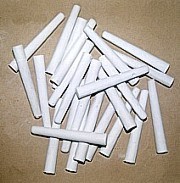
|
|
 |
- Gun Metal Chalk Mould with Copper Pins on fibre glass plates for ejection of chalk sticks |
Standard Accessories: 2 G.I. Trays, 2 Knives, Rubber Sheet |
|
VIDEO OF THE CHALK STICK MAKING
MACHINE
| INSTRUCTION MANUAL FOR CHALK MAKING MACHINE |
 |
MACHINE FOR MAKING SEAMLESS TAPER CHALK STICKS |
The machine has the following items: 1. One piece Gun-Metal
body mould |
|
| Other items required to start production (not supplied by us): | |
| i. Jug | ii. Pot / Vessel | iii. Glass / Mug | iv. Cotton Cloth | v. Kerosene | vi. Mustard Oil | vii. Plaster of Paris (raw material) | viii. Water |
| Machine Operation: |
| 1. | First of all, clean the machine with Kerosene oil / Petrol to remove all the dust / Grease / oil (except item no. 5 (wooden base) supplied with machine). |
| 2. | Apply fresh Lubricant oil to the Rack-Gears & brackets, which hold the Gun-Metal mould. |
| 3. | Apply oil (mixture of Kerosene oil & Mustard oil in 50:50 ratio) at the upper portion of the mould (side having bigger diameter holes) with the help of a brush so that the oil goes down the entire mould. |
| 4. | Cover the wooden
base with wet cotton cloth, 4-5 folds, and place it on the M. S. plate
just below the Gun – Metal mould. Operate the lower handle of machine so
that this wooden base with the wet cotton cloth touches / stick to the
lower part of the Gun Metal mould (Side where the hole diameter is
smaller). Now lock the machine / handle with the lever provided near the
handle. The wet cotton cloth at the base of the mould will prevent leakage of plaster of Paris and will also soak the access water from the mixture of plaster of Paris & water. |
| 5. | Now operate the upper handle of the machine & bring the Aluminium plate with Copper / Brass pins to maximum upper limit, to enable pouring of the mixture of Plaster of Paris & water. |
| 6. | Preparing the
Plaster of Paris Mix: Take a pot / vessel and pour some water in it. Add
the Plaster of Paris to this water. NOTE: Refrain from pouring water over Plaster of Paris as then the water will not mix well and evenly, resulting in lumps. |
| 7. | Now stir the
mixture of Plaster of Paris & water thoroughly by hand or with a stick
as may be convenient to you. NOTE: Only mix enough quantity of Plaster of Paris & water that may be required for one charge of the mould, as the mixture sets very fast, and once set, becomes unusable. At the same time, see to it that the quantity of mixture is sufficient for one charge of the mould, because, if the mixture is not sufficient and if you make another mix and add it in the mould, you will get breakage of chalks. |
| 8. | Pour this mixture from the top of the Gun-metal mould (i.e. from the side where the hole diameter is larger) & allow the mixture to settle down. |
| 9. | After 4 to 5 minutes of pouring the mixture into the mould, remove the excess mixture from the top of the mould with the help of the steel knife provided. |
| 10. | Remove the wooden base & cotton cloth from under the mould and invert the mould using the lever so that the mould side having larger diameter holes face down. |
| 11. | Put the G.I. tray / box on the plate and touch it to the mould. |
| 12. | Bring down the
Aluminium plate with pins by operating the upper handle of the machine
& apply a little pressure. The pins will press the chalks out of their respective moulds, and the Chalk Sticks will be collected in the G.I. tray. |
| 13. | Now, take the Aluminium plate with pins back up by operating the upper handle and remove the G.I. tray (with the ready chalk sticks) |
| 14. | Put this tray (with ready chalk sticks) out in the open for drying under the sun. For quicker drying of the chalk sticks, you could use an electric oven. |
| 15. | For producing the next batch of chalk sticks, rotate the mould back to its first position (with the side having larger hole diameter facing skywards), lubricate the mould with the 50:50 mixture of Kerosene & Mustard oil, mix the next batch of Plaster of Paris & water, and continue production (from point no. 8 stated above) |
| Caution: |
|
- Do not pour
the mixture of Plaster of Paris & water into the mould without oiling
the mould with a 50:50 mixture of Kerosene & Mustard oil. |
 |
Maneklal Global Exports |
|
TO OUR PAGE ON SMALL SCALE INDUSTRY PROJECTS |